Transformation of Phytoplankton Communities in the High Arctic: Ecological Properties of Species
Abstract
1. Introduction
2. Materials and Methods
2.1. Field Studies
2.2. Species Identification
2.3. Nutrient Analysis
2.4. Ice Cover
2.5. Statistical Analysis
3. Results
3.1. Hydrography
3.2. Phytoplankton Community Composition
3.3. Diatoms
3.4. Dinoflagellates
4. Discussion
4.1. Water Masses
4.2. Phytoplankton Community
4.3. Diatoms
4.4. Dinoflagellates
4.5. Main Patterns and Trends
5. Conclusions
Supplementary Materials
Author Contributions
Funding
Institutional Review Board Statement
Informed Consent Statement
Data Availability Statement
Acknowledgments
Conflicts of Interest
References
- England, M.R.; Eisenman, I.; Lutsko, N.J.; Wagner, T.J.W. The Recent Emergence of Arctic Amplification. Geophys. Res. Lett. 2021, 48, e2021GL094086. [Google Scholar] [CrossRef]
- Rantanen, M.; Karpechko, A.Y.; Lipponen, A.; Nordling, K.; Hyvärinen, O.; Ruosteenoja, K.; Vihma, T.; Laaksonen, A. The Arctic Has Warmed Nearly Four Times Faster than the Globe since 1979. Commun. Earth Environ. 2022, 3, 168. [Google Scholar] [CrossRef]
- Onarheim, I.H.; Eldevik, T.; Smedsrud, L.H.; Stroeve, J.C. Seasonal and Regional Manifestation of Arctic Sea Ice Loss. J. Clim. 2018, 31, 4917–4932. [Google Scholar] [CrossRef]
- Previdi, M.; Smith, K.L.; Polvani, L.M. Arctic Amplification of Climate Change: A Review of Underlying Mechanisms. Environ. Res. Lett. 2021, 16, 093003. [Google Scholar] [CrossRef]
- Kwok, R. Arctic Sea Ice Thickness, Volume, and Multiyear Ice Coverage: Losses and Coupled Variability (1958–2018). Environ. Res. Lett. 2018, 13, 105005. [Google Scholar] [CrossRef]
- Meredith, P.M.; Sommerkorn, M.; Cassotta, S.; Derksen, C.; Ekaykin, A.A.; Hollowed, A.B.; Kofinas, G.; Mackintosh, A.N.; Costa Muelbert, M.M.; Melbourne-Thomas, J.; et al. Polar Regions. In IPCC Special Report on the Ocean and Cryosphere in a Changing Climate; Pörtner, H.-O., Roberts, D.C., Masson-Delmotte, V., Zhai, P., Tignor, M., Poloczanska, E., Mintenbeck, K., Alegría, A., Nicolai, M., Okem, A., et al., Eds.; IPCC: Geneva, Switzerland, 2019; pp. 203–320. [Google Scholar]
- Jahn, A.; Holland, M.M.; Kay, J.E. Projections of an ice-free Arctic Ocean. Nat. Rev. Earth Environ. 2024, 5, 164–176. [Google Scholar] [CrossRef]
- Polyakov, I.V.; Pnyushkov, A.V.; Alkire, M.B.; Ashik, I.M.; Baumann, T.M.; Carmack, E.C.; Goszczko, I.; Guthrie, J.; Ivanov, V.V.; Kanzow, T.; et al. Greater Role for Atlantic Inflows on Sea-Ice Loss in the Eurasian Basin of the Arctic Ocean. Science 2017, 356, 285–291. [Google Scholar] [CrossRef]
- Polyakov, I.V.; Alkire, M.B.; Bluhm, B.A.; Brown, K.A.; Carmack, E.C.; Chierici, M.; Danielson, S.L.; Ellingsen, I.; Ershova, E.A.; Gårdfeldt, K.; et al. Borealization of the Arctic Ocean in Response to Anomalous Advection from Sub-Arctic Seas. Front. Mar. Sci. 2020, 7, 491. [Google Scholar] [CrossRef]
- Pnyushkov, A.V.; Polyakov, I.V.; Alekseev, G.V.; Ashik, I.M.; Baumann, T.M.; Carmack, E.C.; Ivanov, V.V.; Rember, R. A Steady Regime of Volume and Heat Transports in the Eastern Arctic Ocean in the Early 21st Century. Front. Mar. Sci. 2021, 8, 705608. [Google Scholar] [CrossRef]
- Årthun, M.; Eldevik, T.; Smedsrud, L.H.; Skagseth, O.; Ingvaldsen, R.B. Quantifying the Influence of Atlantic Heat on Barents Sea Ice Variability and Retreat. J. Clim. 2012, 25, 4736–4743. [Google Scholar] [CrossRef]
- Wang, Q.; Wekerle, C.; Wang, X.; Danilov, S.; Koldunov, N.; Sein, D.; Sidorenko, D.; von Appen, W.-J.; Jung, T. Intensification of the Atlantic Water Supply to the Arctic Ocean through Fram Strait Induced by Arctic Sea Ice Decline. Geophys. Res. Lett. 2020, 47, e2019GL086682. [Google Scholar] [CrossRef]
- Tesi, T.; Muschitiello, F.; Mollenhauer, G.; Miserocchi, S.; Langone, L.; Ceccarelli, C.; Panieri, G.; Chiggiato, J.; Nogarotto, A.; Hefter, J.; et al. Rapid Atlantification along the Fram Strait at the Beginning of the 20th Century. Sci. Adv. 2021, 7, eabj2946. [Google Scholar] [CrossRef]
- Syvertsen, E.E. Ice Algae in the Barents Sea: Types of Assemblages, Origin, Fate and Role in the Ice-Edge Phytoplankton Bloom. Polar Res. 1991, 10, 277–288. [Google Scholar] [CrossRef]
- Fernández-Méndez, M.; Olsen, L.M.; Kauko, H.M.; Meyer, A.; Rösel, A.; Merkouriadi, I.; Mundy, C.J.; Ehn, J.K.; Johansson, A.M.; Wagner, P.M.; et al. Algal Hot Spots in a Changing Arctic Ocean: Sea-Ice Ridges and the Snow-Ice Interface. Front. Mar. Sci. 2018, 5, 75. [Google Scholar] [CrossRef]
- Hop, H.; Poltermann, M.; Lønne, O.J.; Falk-Petersen, S.; Korsnes, R.; Budgell, W.P. Ice Amphipod Distribution Relative to Ice Density and Under-Ice Topography in the Northern Barents Sea. Polar Biol. 2020, 23, 357–367. [Google Scholar] [CrossRef]
- Hegseth, E.N.; Sundfjord, A. Intrusion and Blooming of Atlantic Phytoplankton Species in the High Arctic. J. Mar. Syst. 2008, 74, 108–119. [Google Scholar] [CrossRef]
- Wassmann, P.; Duarte, C.M.; Agustí, S.; Sejr, M.K. Footprints of Climate Change in the Arctic Marine Ecosystem. Glob. Change Biol. 2011, 17, 1235–1249. [Google Scholar] [CrossRef]
- Kahru, M.; Brotas, V.; Manzano-Sarabia, M.; Mitchell, B.G. Are Phytoplankton Blooms Occurring Earlier in the Arctic? Glob. Change Biol. 2011, 17, 1733–1739. [Google Scholar] [CrossRef]
- Oziel, L.; Neukermans, G.; Ardyna, M.; Lancelot, C.; Tison, J.-L.; Wassmann, P.; Sirven, J.; Ruiz-Pino, D.; Gascard, J.-C. Role for Atlantic Inflows and Sea Ice Loss on Shifting Phytoplankton Blooms in the Barents Sea. J. Geophys. Res. Oceans 2017, 122, 5121–5139. [Google Scholar] [CrossRef]
- Assmy, P.; Fernández-Méndez, M.; Duarte, P.; Meyer, A.; Randelhoff, A.; Mundy, C.J.; Olsen, L.M.; Kauko, H.M.; Bailey, A.; Chierici, M.; et al. Leads in Arctic pack ice enables early phytoplankton blooms below snow-covered sea ice. Sci. Rep. 2017, 7, 40850. [Google Scholar] [CrossRef]
- Neukermans, G.; Oziel, L.; Babin, M. Increased Intrusion of Warming Atlantic Water Leads to Rapid Expansion of Temperate Phytoplankton in the Arctic. Glob. Change Biol. 2018, 24, 2545–2553. [Google Scholar] [CrossRef] [PubMed]
- Oziel, L.; Baudena, A.; Ardyna, M.; Massicotte, P.; Randelhoff, A.; Sallée, J.-B.; Ingvaldsen, R.B.; Devred, E.; Babin, M. Faster Atlantic Currents Drive Poleward Expansion of Temperate Phytoplankton in the Arctic Ocean. Nat. Commun. 2020, 11, 1705. [Google Scholar] [CrossRef] [PubMed]
- Hegseth, E.N.; von Quillfeldt, C.H. The Sub-Ice Algal Communities of the Barents Sea Pack Ice: Temporal and Spatial Distribution of Biomass and Species. J. Mar. Sci. Eng. 2022, 10, 164. [Google Scholar] [CrossRef]
- Weydmann, A.; Carstensen, J.; Goszczko, I.; Dmoch, K.; Olszewska, A.; Kwaśniewski, S. Shift towards the Dominance of Boreal Species in the Arctic: Inter-Annual and Spatial Zooplankton Variability in the West Spitsbergen Current. Mar. Ecol. Prog. Ser. 2014, 501, 41–52. [Google Scholar] [CrossRef]
- Fossheim, M.; Primicerio, R.; Johannesen, E.; Ingvaldsen, R.B.; Aschan, M.M.; Dolgov, A.V. Recent Warming Leads to a Rapid Borealization of Fish Communities in the Arctic. Nat. Clim. Change 2015, 5, 673–677. [Google Scholar] [CrossRef]
- Vihtakari, M.; Welcker, J.; Moe, B.; Chastel, O.; Tartu, S.; Hop, H.; Bech, C.; Descamps, S.; Gabrielsen, G.W. Black-Legged Kittiwakes as Messengers of Atlantification in the Arctic. Sci. Rep. 2018, 8, 1178. [Google Scholar] [CrossRef]
- Mańko, M.K.; Gluchowska, M.; Weydmann-Zwolicka, A. Footprints of Atlantification in the Vertical Distribution and Diversity of Gelatinous Zooplankton in the Fram Strait (Arctic Ocean). Prog. Oceanogr. 2020, 189, 102414. [Google Scholar] [CrossRef]
- Benedetti, F.; Vogt, M.; Elizondo, U.H.; Righetti, D.; Zimmermann, N.E.; Gruber, N. Major Restructuring of Marine Plankton Assemblages under Global Warming. Nat. Commun. 2021, 12, 5226. [Google Scholar] [CrossRef]
- Priest, T.; Von Appen, W.-J.; Oldenburg, E.; Popa, O.; Torres-Valdés, S.; Bienhold, C.; Metfies, K.; Boulton, W.; Mock, T.; Fuchs, B.M.; et al. Atlantic Water Influx and Sea-Ice Cover Drive Taxonomic and Functional Shifts in Arctic Marine Bacterial Communities. ISME J. 2023, 17, 1612–1625. [Google Scholar] [CrossRef]
- Nicolaus, M.; Katlein, C.; Maslanik, J.; Hendricks, S. Changes in Arctic Sea Ice Result in Increasing Light Transmittance and Absorption. Geophys. Res. Lett. 2012, 39, L24501. [Google Scholar] [CrossRef]
- Horvat, C.; Jones, D.R.; Iams, S.; Schroeder, D.; Flocco, D.; Feltham, D. The Frequency and Extent of Sub-Ice Phytoplankton Blooms in the Arctic Ocean. Sci. Adv. 2017, 3, e1601191. [Google Scholar] [CrossRef] [PubMed]
- Arrigo, K.R.; Perovich, D.K.; Pickart, R.S.; Brown, Z.W.; van Dijken, G.L.; Lowry, K.E.; Mills, M.M.; Palmer, M.A.; Balch, W.M.; Bahr, F.; et al. Massive Phytoplankton Blooms under Arctic Sea Ice. Science 2012, 336, 1408. [Google Scholar] [CrossRef] [PubMed]
- Arrigo, K.R.; Perovich, D.K.; Pickart, R.S.; Brown, Z.W.; van Dijken, G.L.; Lowry, K.E.; Mills, M.M.; Palmer, M.A.; Balch, W.M.; Bahr, F.; et al. Phytoplankton Blooms Beneath the Sea Ice in the Chukchi Sea. Deep Sea Res. Part II Top. Stud. Oceanogr. 2014, 105, 1–16. [Google Scholar] [CrossRef]
- Ardyna, M.; Mundy, C.J.; Mayot, N.; Matthes, L.C.; Oziel, L.; Horvat, C.; Leu, E.; Assmy, P.; Hill, V.; Matrai, P.A.; et al. Under-Ice Phytoplankton Blooms: Shedding Light on the “Invisible” Part of Arctic Primary Production. Front. Mar. Sci. 2020, 7, 608032. [Google Scholar] [CrossRef]
- Oziel, L.; Massicotte, P.; Randelhoff, A.; Ferland, J.; Vladoiu, A.; Lacour, L.; Babin, M. Environmental Factors Influencing the Seasonal Dynamics of Spring Algal Blooms in and Beneath Sea Ice in Western Baffin Bay. Elem. Sci. Anthr. 2019, 7, 34. [Google Scholar] [CrossRef]
- Ardyna, M.; Arrigo, K.R. Phytoplankton Dynamics in a Changing Arctic Ocean. Nat. Clim. Change 2020, 10, 892–903. [Google Scholar] [CrossRef]
- Dąbrowska, A.M.; Wiktor, J.M., Jr.; Merchel, M.; Wiktor, J.M. Planktonic Protists of the Eastern Nordic Seas and the Fram Strait: Spatial Changes Related to Hydrography During Early Summer. Front. Mar. Sci. 2020, 7, 557. [Google Scholar] [CrossRef]
- Beszczynska-Möller, A.; Fahrbach, E.; Schauer, U.; Hansen, E. Variability in Atlantic Water Temperature and Transport at the Entrance to the Arctic Ocean, 1997–2010. ICES J. Mar. Sci. 2012, 69, 852–863. [Google Scholar] [CrossRef]
- Walczowski, W. Frontal Structures in the West Spitsbergen Current Margins. Ocean Sci. 2013, 9, 957–975. [Google Scholar] [CrossRef]
- Hattermann, T.; Isachsen, P.E.; von Appen, W.-J.; Albretsen, J.; Sundfjord, A. Eddy-Driven Recirculation of Atlantic Water in Fram Strait. Geophys. Res. Lett. 2016, 43, 3406–3414. [Google Scholar] [CrossRef]
- Rudels, B.; Carmack, E.C. Arctic Ocean Water Mass Structure and Circulation. Oceanography 2022, 35, 52–65. [Google Scholar] [CrossRef]
- Anderson, S.I.; Franzè, G.; Kling, J.D.; Wilburn, P.; Kremer, C.T.; Menden-Deuer, S.; Litchman, E.; Hutchins, D.A.; Rynearson, T.A. The Interactive Effects of Temperature and Nutrients on a Spring Phytoplankton Community. Limnol. Oceanogr. 2022, 67, 634–645. [Google Scholar] [CrossRef]
- Garzke, J.; Connor, S.J.; Sommer, U.; O’Connor, M.I. Trophic Interactions Modify the Temperature Dependence of Community Biomass and Ecosystem Function. PLoS Biol. 2019, 17, e2006806. [Google Scholar] [CrossRef] [PubMed]
- Giesler, J.K.; Harder, T.; Wohlrab, S. Microbiome and Photoperiod Interactively Determine Thermal Sensitivity of Polar and Temperate Diatoms. Biol. Lett. 2023, 19, 20230151. [Google Scholar] [CrossRef] [PubMed]
- Litchman, E.; Thomas, M.K. Are We Underestimating the Ecological and Evolutionary Effects of Warming? Interactions with Other Environmental Drivers May Increase Species Vulnerability to High Temperatures. Oikos 2023, 2023, e09155. [Google Scholar] [CrossRef]
- Sakshaug, E.; Slagstad, D. Light and Productivity of Phytoplankton in Polar Marine Ecosystems: A Physiological View. Polar Res. 1991, 10, 69–85. [Google Scholar] [CrossRef]
- Edwards, K.F.; Thomas, M.K.; Klausmeier, C.A.; Litchman, E. Phytoplankton Growth and the Interaction of Light and Temperature: A Synthesis at the Species and Community Level. Limnol. Oceanogr. 2016, 61, 1232–1244. [Google Scholar] [CrossRef]
- Thomas, M.K.; Aranguren-Gassis, M.; Kremer, C.T.; Gould, M.R.; Anderson, K.; Klausmeier, C.A.; Litchman, E. Temperature—Nutrient Interactions Exacerbate Sensitivity to Warming in Phytoplankton. Glob. Change Biol. 2017, 23, 3269–3280. [Google Scholar] [CrossRef]
- Boyd, P.W. Physiology and iron modulate diverse responses of diatoms to a warming Southern Ocean. Nat. Clim. Change 2019, 9, 148–152. [Google Scholar] [CrossRef]
- Thomas, M.K.; Kremer, C.T.; Klausmeier, C.A.; Litchman, E. A Global Pattern of Thermal Adaptation in Marine Phytoplankton. Science 2012, 338, 1085–1088. [Google Scholar] [CrossRef]
- Pinsky, M.L.; Selden, R.L.; Kitchel, Z.J. Climate-Driven Shifts in Marine Species Ranges: Scaling from Organisms to Communities. Annu. Rev. Mar. Sci. 2020, 12, 153–179. [Google Scholar] [CrossRef]
- Tomas, C.R.; Hasle, G.R.; Syvertsen, E.E.; Steidinger, K.A.; Tangen, K.; Throndsen, J.; Heimdal, B.R. Identifying Marine Phytoplankton; Academic Press: San Diego, CA, USA, 1997. [Google Scholar]
- Throndsen, J.; Hasle, G.R.; Tangen, K. Phytoplankton of Norwegian Coastal Waters; Almater Forlag AS: Oslo, Norway, 2007. [Google Scholar]
- Hillebrand, H.; Dürselen, C.-D.; Kirschtel, D.; Pollingher, U.; Zohary, T. Biovolume Calculation for Pelagic and Benthic Microalgae. J. Phycol. 1999, 35, 403–424. [Google Scholar] [CrossRef]
- Bordovskiy, O.K.; Chernyakova, A.M. (Eds.) Modern Methods of the Ocean Hydrochemical Investigations; P.P. Shirshov Institute of Oceanology: Moscow, Russia, 1992; 200p. (In Russian) [Google Scholar]
- Grasshoff, K.; Kremling, K.; Ehrhardt, M. Methods of Seawater Analysis; Wiley-VCH: Weinheim, Germany, 1999; p. 420. [Google Scholar]
- Perez-Hernandez, M.D.; Pickart, R.S.; Pavlov, V.; Våge, K.; Ingvaldsen, R.; Sundfjord, A.; Renner, A.H.H.; Torres, D.J.; Erofeeva, S.Y. The Atlantic Water Boundary Current in the Nansen Basin: Transport and Mechanisms of Lateral Exchange. J. Geophys. Res. Oceans 2017, 122, 1976–1992. [Google Scholar]
- Fragoso, G.M.; Poulton, A.J.; Yashayaev, I.M.; Head, E.J.H.; Johnsen, G.; Purdie, D.A. Diatom Biogeography from the Labrador Sea Revealed Through a Trait-Based Approach. Front. Mar. Sci. 2018, 5, 297. [Google Scholar] [CrossRef]
- Sundfjord, A.; Assmann, K.M.; Lundesgaard, Ø.; Renner, A.H.H.; Lind, S.; Ingvaldsen, R.B. Suggested water mass definitions for the central and northern Barents Sea, and the adjacent Nansen Basin: Workshop Report. The Nansen Legacy Report Series. 2020. [Google Scholar] [CrossRef]
- Flores, H.; David, C.; Ehrlich, J.; Hardge, K.; Kohlbach, D.; Lange, B.A.; Niehoff, B.; Nöthig, E.-M.; Peeken, I.; Metfies, K. Sea-Ice Properties and Nutrient Concentration as Drivers of the Taxonomic and Trophic Structure of High-Arctic Protist and Metazoan Communities. Polar Biol. 2019, 42, 1377–1395. [Google Scholar] [CrossRef]
- Raven, J.A.; Geider, R.J. Temperature and Algal Growth. New Phytol. 1988, 110, 441–461. [Google Scholar] [CrossRef]
- Malviya, S.; Scalco, E.; Audic, S.; Vincent, F.; Veluchamy, A.; Poulain, J.; Wincker, P.; Iudicone, D.; de Vargas, C.; Bittner, L.; et al. Insights into global diatom distribution and diversity in the world’s ocean. Proc. Natl. Acad. Sci. USA 2016, 113, E1516–E1525. [Google Scholar] [CrossRef]
- Tréguer, P.; Bowler, C.; Moriceau, B.; Dutkiewicz, S.; Gehlen, M.; Aumont, O.; Bittner, L.; Dugdale, R.; Finkel, Z.; Iudicone, D.; et al. Influence of diatom diversity on the ocean biological carbon pump. Nature Geosci. 2018, 11, 27–37. [Google Scholar] [CrossRef]
- Kaiser, P.; Hagen, W.; Schukat, A.; Metfies, K.; Biederbick, J.; Dorschner, S.; Auel, H. Phytoplankton Diversity and Zooplankton Diet Across Fram Strait: Spatial Patterns with Implications for the Future Arctic Ocean. Prog. Oceanogr. 2025, 234, 103423. [Google Scholar] [CrossRef]
- Šupraha, L.; Klemm, K.; Gran-Stadniczeñko, S.; Hörstmann, C.; Vaulot, D.; Edvardsen, B.; John, U. Diversity and Biogeography of Planktonic Diatoms in Svalbard Fjords: The Role of Dispersal and Arctic Endemism in Phytoplankton Community Structuring. Elem. Sci. Anthr. 2022, 10, 00117. [Google Scholar] [CrossRef]
- Johnsen, G.; Norli, M.; Moline, M.; Robbins, I.; von Quillfeldt, C.; Sørensen, K.; Cottier, F.; Berge, J. The Advective Origin of an Under-Ice Spring Bloom in the Arctic Ocean Using Multiple Observational Platforms. Polar Biol. 2018, 41, 1197–1216. [Google Scholar] [CrossRef] [PubMed]
- Pautova, L.; Silkin, V.; Kravchishina, M.; Klyuvitkin, A.; Kudryavtseva, E.; Glukhovets, D.; Chultsova, A.; Politova, N. Phytoplankton of the High-Latitude Arctic: Intensive Growth of Large Diatoms Porosira glacialis in the Nansen Basin. J. Mar. Sci. Eng. 2023, 11, 453. [Google Scholar] [CrossRef]
- Pautova, L.; Kravchishina, M.; Silkin, V.; Klyuvitkin, A.; Chultsova, A.; Vazyulya, S.; Glukhovets, D.; Artemyev, V. The Influence of the Atlantic Water Boundary Current on the Phytoplankton Composition and Biomass in the Northern Barents Sea and the Adjacent Nansen Basin. J. Mar. Sci. Eng. 2024, 12, 1678. [Google Scholar] [CrossRef]
- Balzano, S.; Percopo, I.; Siano, R.; Gourvil, P.; Chanoine, M.; Marie, D.; Vaulot, D.; Sarno, D. Morphological and Genetic Diversity of Beaufort Sea Diatoms with High Contributions from the Chaetoceros neogracilis Species Complex. J. Phycol. 2017, 53, 161–187. [Google Scholar] [CrossRef]
- Egge, J.K.; Aksnes, D.L. Silicate as Regulating Nutrient in Phytoplankton Competition. Mar. Ecol. Prog. Ser. 1992, 83, 281–289. [Google Scholar] [CrossRef]
- Krause, J.W.; Brzezinski, M.A.; Villareal, T.A.; Wilson, C. Increased Kinetic Efficiency for Silicic Acid Uptake as a Driver of Summer Diatom Blooms in the North Pacific Subtropical Gyre. Limnol. Oceanogr. 2012, 57, 1084–1098. [Google Scholar] [CrossRef]
- Krause, J.W.; Duarte, C.M.; Marquez, I.A.; Assmy, P.; Fernández-Méndez, M.; Wiedmann, I.; Wassmann, P.; Kristiansen, S.; Agustí, S. Biogenic Silica Production and Diatom Dynamics in the Svalbard Region during Spring. Biogeosciences 2018, 15, 6503–6517. [Google Scholar] [CrossRef]
- Mills, M.M.; Brown, Z.W.; Laney, S.R.; Ortega-Retuerta, E.; Lowry, K.E.; van Dijken, G.L.; Arrigo, K.R. Nitrogen Limitation of the Summer Phytoplankton and Heterotrophic Prokaryote Communities in the Chukchi Sea. Front. Mar. Sci. 2018, 5, 362. [Google Scholar] [CrossRef]
- Lewis, K.M.; van Dijken, G.L.; Arrigo, K.R. Changes in Phytoplankton Concentration Now Drive Increased Arctic Ocean Primary Production. Science 2020, 369, 198–202. [Google Scholar] [CrossRef]
- Tremblay, J.-É.; Michel, C.; Hobson, K.A.; Gosselin, M.; Price, N.M. Bloom Dynamics in Early Opening Waters of the Arctic Ocean. Limnol. Oceanogr. 2006, 51, 900–912. [Google Scholar] [CrossRef]
- Henley, S.F.; Porter, M.; Hobbs, L.; Braun, J.; Guillaume-Castel, R.; Venables, E.J.; Dumont, E.; Cottier, F. Nitrate Supply and Uptake in the Atlantic Arctic Sea Ice Zone: Seasonal Cycle, Mechanisms and Drivers. Philos. Trans. R. Soc. A 2020, 378, 20190361. [Google Scholar] [CrossRef] [PubMed]
- Koenig, Z.; Muilwijk, M.; Sandven, H.; Lundesgaard, Ø.; Assmy, P.; Lind, S.; Assmann, K.M.; Chierici, M.; Fransson, A.; Gerland, S.; et al. From Winter to Late Summer in the Northwestern Barents Sea Shelf: Impacts of Seasonal Progression of Sea Ice and Upper Ocean on Nutrient and Phytoplankton Dynamics. Prog. Oceanogr. 2024, 220, 103174. [Google Scholar] [CrossRef]
- Silkin, V.; Fedorov, A.; Flynn, K.J.; Paramonov, L.; Pautova, L. Protoplasmic streaming of chloroplasts enables rapid photoacclimation in large diatoms. J. Plankton Res. 2021, 43, 831–845. [Google Scholar] [CrossRef]
- Margalef, R. Life-Forms of Phytoplankton as Survival Alternatives in an Unstable Environment. Oceanol. Acta 1978, 1, 493–509. [Google Scholar]
- Wassmann, P.; Ratkova, T.; Andreassen, I.; Vernet, M.; Pedersen, G.; Rey, F. Spring Bloom Development in the Marginal Ice Zone and the Central Barents Sea. Mar. Ecol. 1999, 20, 321–346. [Google Scholar] [CrossRef]
- Kubiszyn, A.M.; Wiktor, J.M.; Griffiths, C.; Kristiansen, S.; Gabrielsen, T.M. The Annual Planktonic Protist Community Structure in an Ice-Free High Arctic Fjord (Adventfjorden, West Spitsbergen). J. Mar. Syst. 2017, 169, 61–72. [Google Scholar] [CrossRef]
- Luan, Q.; Mitchell, E.; Henley, S.F.; Orkney, A.C.M.; Bouman, H.A.; Braun, J.S.; Poulton, A.J.; Davidson, K. Water mass influence on spatial and seasonal distributions of diatoms, dinoflagellates and coccolithophores in the western Barents Sea. Polar Biol. 2024, 47, 693–714. [Google Scholar] [CrossRef]
- Flynn, K.J.; Mitra, A.; Anestis, K.; Anschütz, A.A.; Calbet, A.; Ferreira, G.D.; Gypens, N.; Hansen, P.J.; John, U.; Martin, J.L.; et al. Mixotrophic Protists and a New Paradigm for Marine Ecology: Where Does Plankton Research Go Now? J. Plankton Res. 2019, 41, 375–391. [Google Scholar] [CrossRef]
- Mitra, A.; Flynn, K.J.; Stoecker, D.K.; Raven, J.A.; Caron, D.A.; Stoecker, D.K.; Not, F.; Hansen, P.J.; Hallegraeff, G.; Sanders, R.; et al. Trait Trade-Offs in Phagotrophic Microalgae: The Mixoplankton Conundrum. Eur. J. Phycol. 2023, 59, 51–70. [Google Scholar] [CrossRef]
- Seuthe, L.; Iversen, K.R.; Narcy, F. Microbial Processes in a High-Latitude Fjord (Kongsfjorden, Svalbard): II. Ciliates and Dinoflagellates. Polar Biol. 2011, 34, 751–776. [Google Scholar] [CrossRef]
- Stoecker, D.K.; Lavrentyev, P.J. Mixotrophic Plankton in the Polar Seas: A Pan-Arctic Review. Front. Mar. Sci. 2018, 5, 292. [Google Scholar] [CrossRef]
- Barnard, R.; Batten, S.; Beaugrand, G.; Buckland, C.; Conway, D.V.P.; Edwards, M.; Finlayson, J.; Gregory, L.W.; Halliday, N.C.; John, A.W.G.; et al. Continuous Plankton Records: Plankton Atlas of the North Atlantic Ocean (1958–1999). II. Biogeographical Charts. Mar. Ecol. Prog. Ser. Suppl. 2004, 11–75. [Google Scholar]
- Gibert, J.P. Temperature Directly and Indirectly Influences Food Web Structure. Sci. Rep. 2019, 9, 5312. [Google Scholar] [CrossRef]
- Righetti, D.; Vogt, M.; Gruber, N.; Psomas, A.; Zimmermann, N.E. Global Pattern of Phytoplankton Diversity Driven by Temperature and Environmental Variability. Sci. Adv. 2019, 5, eaau6253. [Google Scholar] [CrossRef] [PubMed]
- Von Quillfeldt, C.H. Common Diatom Species in Arctic Spring Blooms: Their Distribution and Abundance. Bot. Mar. 2000, 43, 499–516. [Google Scholar] [CrossRef]
- Wirtz, K.W. Who is eating whom? Morphology and feeding type determine the size relation between planktonic predators and their ideal prey. Mar. Ecol. Prog. Ser. 2012, 445, 1–12. [Google Scholar] [CrossRef]
- Fenchel, T. How Dinoflagellates Swim. Protist 2001, 152, 329–338. [Google Scholar] [CrossRef]
- Fahimi, P.; Irwin, A.J.; Lynch, M. Costs and Benefits of Phytoplankton Motility. arXiv 2025, arXiv:2503.14625. [Google Scholar] [CrossRef]
- Pearson, D.E.; Ortega, Y.K.; Eren, Ö.; Hierro, J.L. Community assembly theory as a framework for biological invasions. Trends Ecol. Evol. 2018, 33, 313–325. [Google Scholar] [CrossRef]
- Tilman, D. Resource competition between planktonic algae: An experimental and theoretical approach. Ecology 1977, 58, 338–348. [Google Scholar] [CrossRef]
- Rihm, G.; Benedetti, F.; Bittner, L. Do trophic strategies shape biogeography and environmental niches? Marine dinoflagellates as a case study. ISME Commun. 2025, 5, ycaf153. [Google Scholar] [CrossRef]

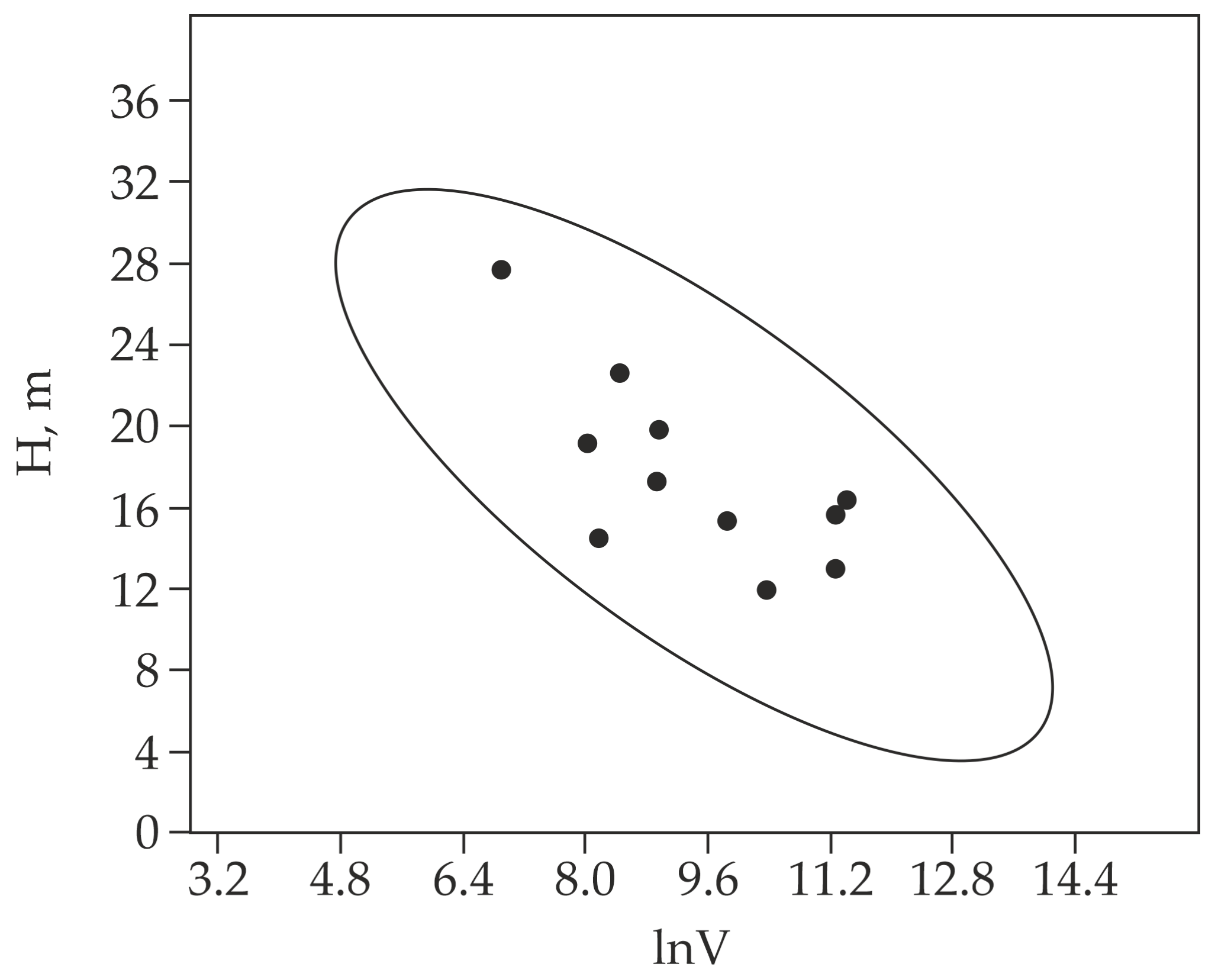
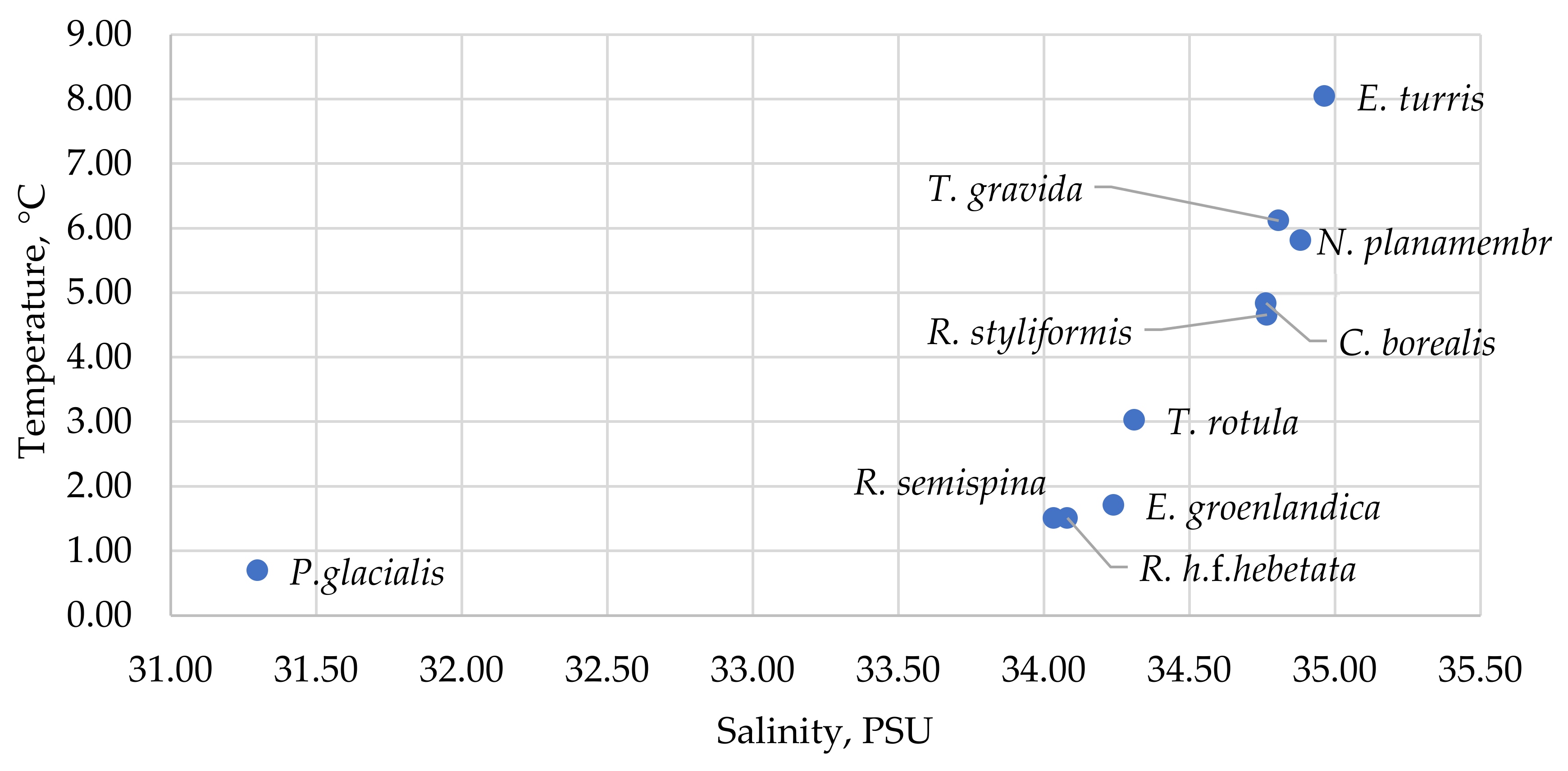
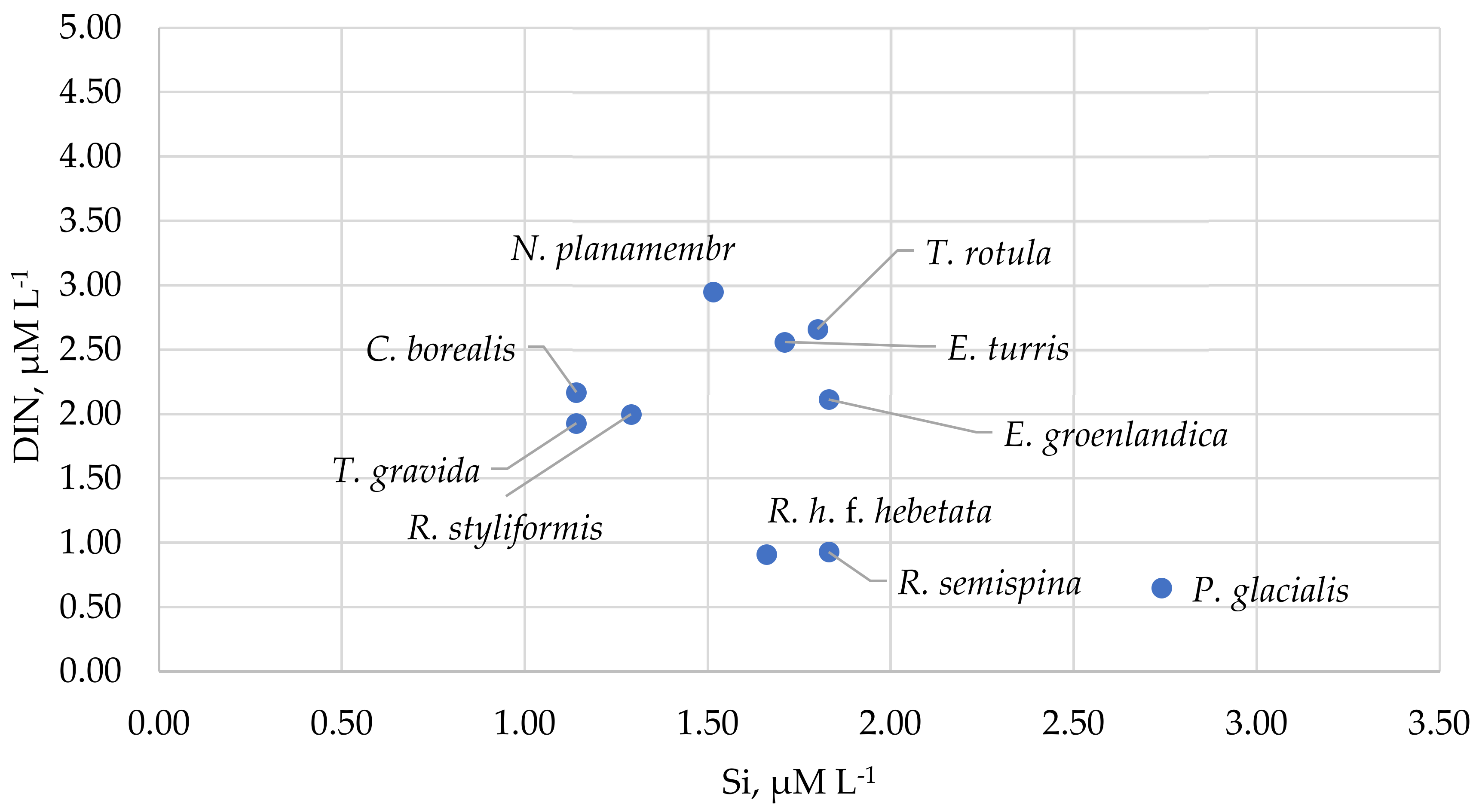
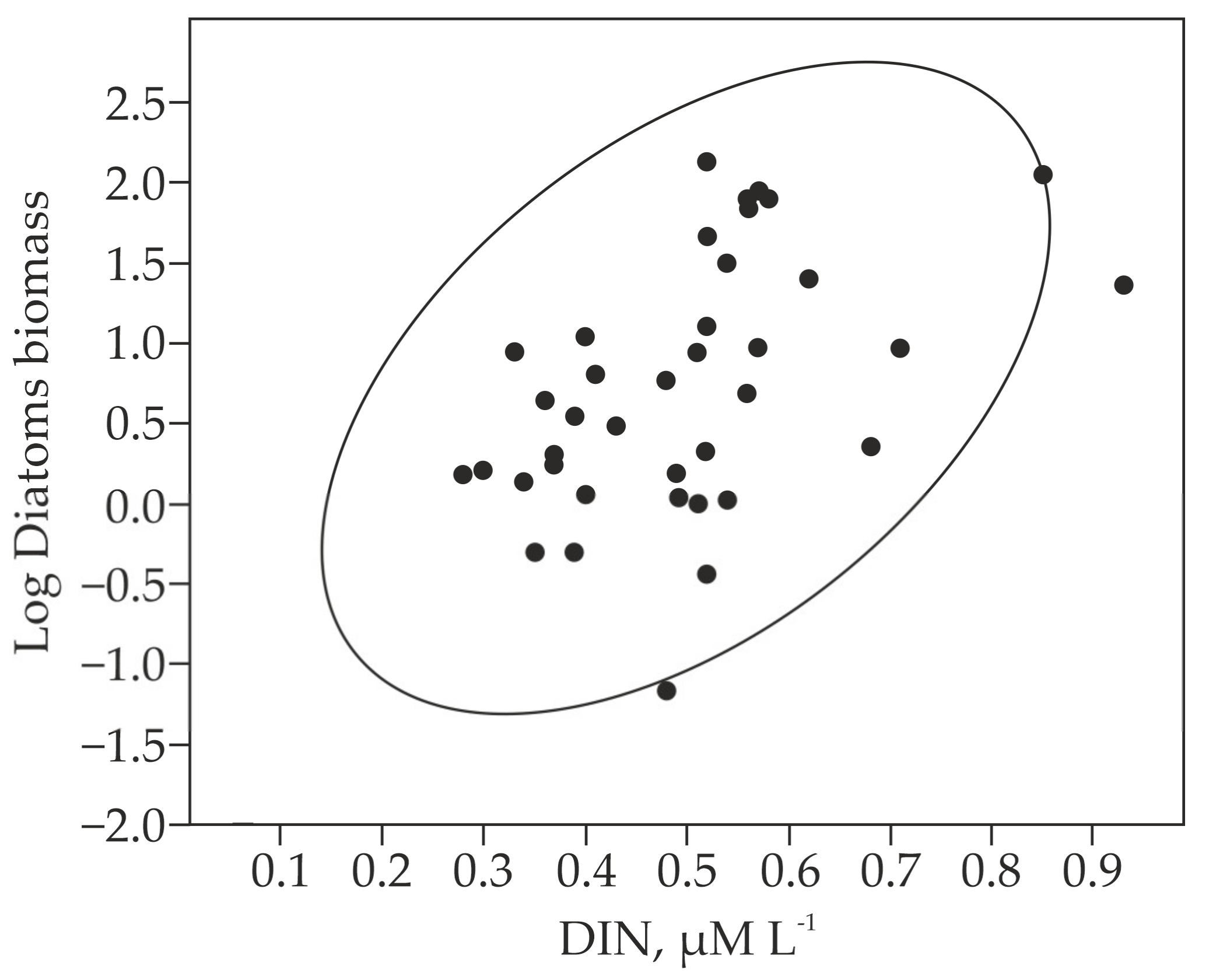
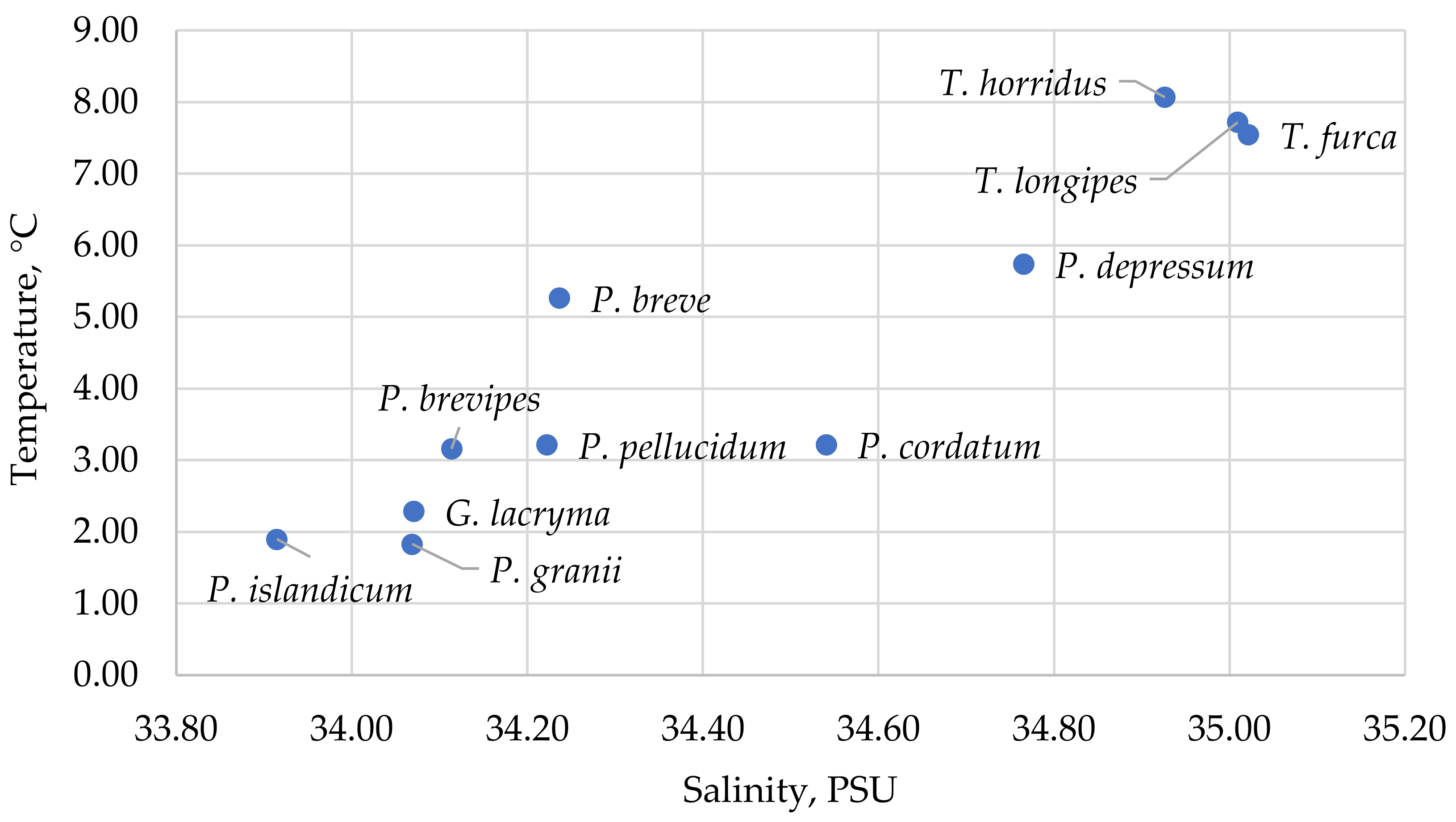

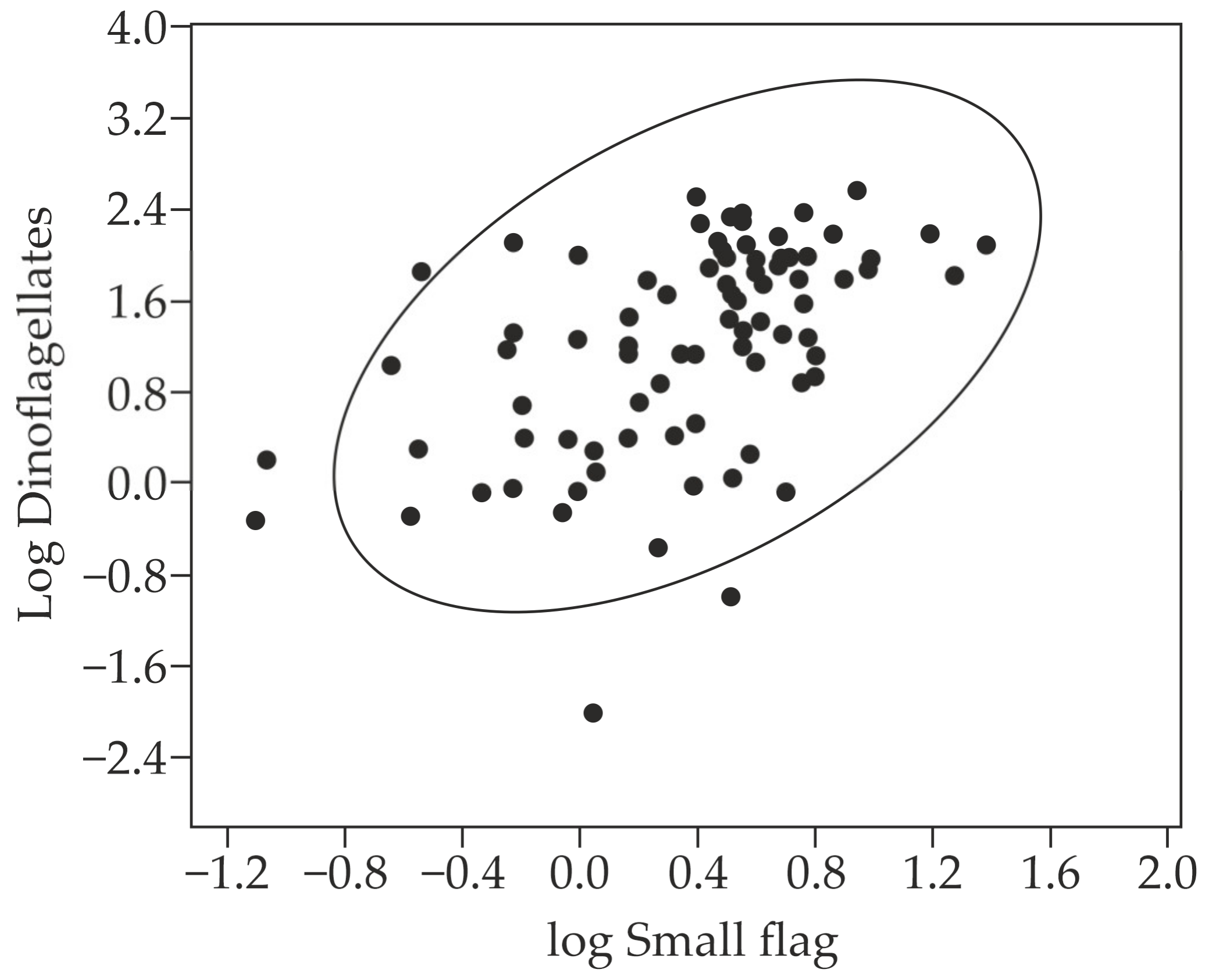
| Water Mass | Potential Temperature | Salinity | Si | DIN |
|---|---|---|---|---|
| AW | θ > 1.544 | 34.75 < S < 35.03 | 0.69 | 1.58 |
| mAW | θ < 4.1 | 34.0 < S < 34.75 | - | - |
| PSW | −1.659 < θ < 3.0 | 31.30 < S < 34.0 | 1.83 | 0.52 |
| mPSW | −1.6 < θ < 0 | 30.85 < S < 31.28 | - | - |
| p (AW vs. PSW) | 7.3 × 10−9 | 9 × 10−6 |
| Group | Biomass (mg m−3) | Contribution (%) | ||||
| Max | Mean | Median | Max | Mean | Median | |
| Diatoms | 617.1 | 19.9 | 1.65 | 96.0 | 21.0 | 1.0 |
| Dinoflagellates | 366.0 | 47.5 | 10.6 | 98.0 | 50.0 | 49.0 |
| Coccolithophores | 47.1 | 2.1 | 0.01 | 92.0 | 9.0 | 0.01 |
| Haptophyta (Phaeocystis) | 206.2 | 2.7 | 0.01 | 80.0 | 0.3 | 0.01 |
| Small flagellates | 56.9 | 3.9 | 2.3 | 77.0 | 13.0 | 7.0 |
| Total Phytoplankton | 670.8 | 66.8 | 25.6 | |||
| n (number of samples) | 205 | 205 | 205 | 205 | 205 | 205 |
| Station | Depth (m) | Dominant Species | Abundance (Cells L−1) | Biomass (mg m−3) | Vcell (µm3) | Contribution (%) |
| Diatoms | ||||||
| 7082 | 34 | Rhizosolenia styliformis | 2300 | 535.3 | 247,400 | 89.3 |
| 7081 | 35 | Rhizosolenia hebetata f. hebetata | 14,500 | 145.5 | 10,000 | 39.0 |
| 7070 | 35 | Thalassiosira rotula | 36,400 | 170.9 | 4700 | 86.7 |
| Ciliates | ||||||
| 7075 | 4 | Mesodinium rubrum | 58,200 | 324.7 | 5580 | 99.3 |
| Dinoflagellates | ||||||
| 7069 | 1 | Gyrodinium lacryma | 380 | 304.0 | 795,800 | 87.1 |
| 7045 | 6 | Protoperidinium depressum | 80 | 114.5 | 1,437,000 | 67.0 |
| Haptophyta | ||||||
| 7081 | 35 | Phaeocystis pouchetii | 727,300 | 196.4 | 270 | 52.2 |
| Parameter | n | Min | Max | Mean | Median |
| Abundance (cells L−1) | 282 | 5 | 112,500 | 1629 | 112 |
| Biomass (mg m−3) | 282 | 0.04 | 535.28 | 13.29 | 2.48 |
| Depth (m) | 275 | 1.0 | 50.0 | 18.5 | 16.0 |
| Salinity (PSU) | 273 | 30.97 | 35.04 | 34.22 | 34.65 |
| Temperature (°C) | 273 | −1.63 | 8.82 | 3.78 | 4.38 |
| Phosphorus (P, µM L−1) | 252 | 0.13 | 1.98 | 0.36 | 0.30 |
| Silicon (Si, µM L−1) | 252 | 0.51 | 4.56 | 1.73 | 1.48 |
| Nitrogen (DIN, µM L−1) | 232 | 0.28 | 9.65 | 2.61 | 2.00 |
| N:P ratio | 242 | 0.85 | 17.81 | 6.80 | 5.88 |
| Si:N ratio | 242 | 0.1 | 7.8 | 1.4 | 0.6 |
| Si:P ratio | 246 | 1.2 | 16.0 | 5.7 | 5.1 |
Disclaimer/Publisher’s Note: The statements, opinions and data contained in all publications are solely those of the individual author(s) and contributor(s) and not of MDPI and/or the editor(s). MDPI and/or the editor(s) disclaim responsibility for any injury to people or property resulting from any ideas, methods, instructions or products referred to in the content. |
© 2025 by the authors. Licensee MDPI, Basel, Switzerland. This article is an open access article distributed under the terms and conditions of the Creative Commons Attribution (CC BY) license (https://creativecommons.org/licenses/by/4.0/).
Share and Cite
Pautova, L.; Silkin, V.; Kravchishina, M.; Klyuvitkin, A. Transformation of Phytoplankton Communities in the High Arctic: Ecological Properties of Species. Diversity 2025, 17, 703. https://doi.org/10.3390/d17100703
Pautova L, Silkin V, Kravchishina M, Klyuvitkin A. Transformation of Phytoplankton Communities in the High Arctic: Ecological Properties of Species. Diversity. 2025; 17(10):703. https://doi.org/10.3390/d17100703
Chicago/Turabian StylePautova, Larisa, Vladimir Silkin, Marina Kravchishina, and Alexey Klyuvitkin. 2025. "Transformation of Phytoplankton Communities in the High Arctic: Ecological Properties of Species" Diversity 17, no. 10: 703. https://doi.org/10.3390/d17100703
APA StylePautova, L., Silkin, V., Kravchishina, M., & Klyuvitkin, A. (2025). Transformation of Phytoplankton Communities in the High Arctic: Ecological Properties of Species. Diversity, 17(10), 703. https://doi.org/10.3390/d17100703








